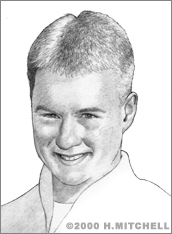Jordan Sand
Jordan Sand was a high school senior (class of 2001) at Ellendale High School in Ellendale, North Dakota who had a bright future as an environmental scientist in the making. At 18 years old, having created a number of devices related to the agricultural world, Sand was already proving that innovation can be applied not only by engineers on mechanical devices, but also to solve environmental and economic issues.
Sand’s parents, and grandparents, are farmers, so he was well aware throughout his early life of the importance of plant health and technology to the family business. He began to combine this awareness with an aptitude for science in the seventh grade, when he built a solar distillation device designed to purify water outdoors during the cold North Dakota winters. Later Sand created a solar-heated birdbath that keeps the birds’ water thawed in cold weather. Both projects were selected to advance to his state science fair.
As a high school sophomore, Sand began researching ways to help farmers create alternative uses for their crops. He found that various types of grain straw, such as flax, wheat and corn, and cattails, could be used to make paper. Using these materials, which are annual plants needing no re-seeding, herbicides or pesticides, to make paper or other products would provide additional income to farmers from crops that would not ordinarily be income-producing, he concluded.
To further his research Sand contacted Ulrike Tschirner, Associate Professor of Wood and Paper Science at the University of Minnesota, who offered to help Sand by allowing him to work for six days in his laboratory. There Sand experimented with chemicals to pulp, bleach and make paper from corn stalks, cattails and cereal straws. Soon after, Sand was selected to attend the International Science and Engineering Fair in Philadelphia.
As winner of the 2000 Lemelson-MIT Invention Apprenticeship for high school students, Sand was given the opportunity to work for a short period with Ashok Gadgil, a senior scientist for the Lawrence Berkeley National Laboratory, a U.S. Dept. of Energy laboratory managed by the University of California. Dr. Gadgil, who conducted research on drinking water disinfection, indoor air pollutants and energy efficiency opportunities, served as Sand’s Invention Mentor on an environmental project that the two designed together.
Sand says he believes his papermaking concept is economically feasible on a global scale. He is also especially interested in helping to improve the general public's perception of genetically engineered crops and foods. Said Sand, "I would just like to see what really needs to be done and try and figure out how to make it better."


